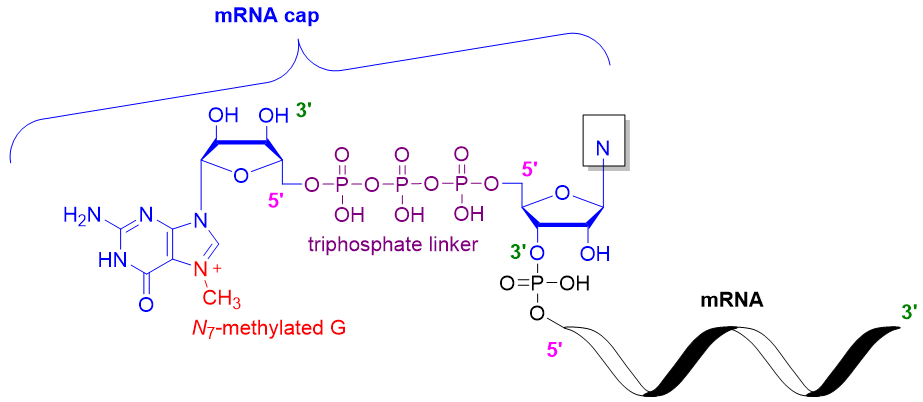- No products in the cart.
An introduction to RNA caps
Protein synthesis is a critical biological process that is divided into two parts. A segment of DNA encoding a specific protein (a gene) is copied to a molecule of messenger RNA during transcription (mRNA). Ribosomes read the nucleotide sequence of the mRNA, which determines the amino acid sequence in the nascent protein, and synthesize the protein during translation. RNA caps play an essential role in this whole process.
Transcription in eukaryotic cells
The transcription process in eukaryotic cells is far more complex than simply reading DNA and synthesizing a complementary mRNA strand. In fact, mRNA is initially produced in a premature form (pre-mRNA), which is then modified by the cell machinery to produce mature mRNA.
A cap is attached to the free 5′ terminus of the mRNA when it is only about 30 nucleotides long. RNA caps are very specific modifications: they are made up of a guanosine nucleotide with a N7-methylated guanine base that is connected to the RNA strand by three phosphates rather than the normal single phosphate. Furthermore, the nucleotide’s orientation is the inverse of that of the RNA oligonucleotide.

Biosynthesis of RNA cap
The mRNA cap is biosynthesised in three steps, each catalyzed by a different enzyme. Because all of these enzymes are bound to RNA polymerase’s long phosphorylated tail, mRNA capping occurs during transcription in the nucleus. The mRNA is first synthesized with a 5’triphosphate group. As a result, the first step in capping is to remove a single phosphate, resulting in a 5′-disphosphate terminus. RNA triphosphatase catalyzes this step.
The mRNA-5′-diphosphate is then bound to a guanosine monophosphate (GMP) by a second enzyme (RNA guanylyltransferase – GTase), forming a triphosphate bond with the new guanosine in reverse orientation.
Finally, the enzyme guanine-N7 methyltransferase (guanine-N7 MTase) methylates the new N7 guanine base.
Additional chemical modification of capped RNA
After being capped, the RNA molecule undergoes additional chemical modifications, including the addition of adenosine nucleotides on the opposite end of the chain (at the 3′-terminus) and the elimination of introns (regions that do not code for a protein) during splicing.
RNA caps in biological processes
RNA capping is a critical step in the production of a stable mature mRNA capable of translation, and it is involved in many functional processes.
The Cap-Binding-Complex (CBC) binds exclusively to m7G-capped mRNA and is responsible for exporting it from the nucleus to the cytoplasm. Other translation factors are used in its place to be recognized by ribosomes. Thus, protein biosynthesis cannot begin without RNA capping.
In addition to its primary function of initiating protein biosynthesis, the mRNA cap protects against cleavage by exonucleases (enzymes that cleave nucleotides one at a time from the end of a polynucleotide chain) – an important role, given that translation in eukaryotes is a relatively long process.
Furthermore, RNA capping serves as an identification group for recruiting protein factors for a variety of other critical cellular processes, such as pre-mRNA splicing, polyadenylation, and intracellular transport.
Santiago lab offers various services for your research. If you are interested, you can read more about our custom synthesis and contract research services.
References
Gingras, AC. 35 years later, mRNA caps still matter. Nat Rev Mol Cell Biol. 2009, 10, 735. https://doi.org/10.1038/nrm2789
Ramanathan A, Robb GB, Chan SH. mRNA capping: biological functions and applications. Nucleic Acids Res. 2016, 44, 7511-26. https://doi: 10.1093/nar/gkw551
Ghosh A, Lima CD. Enzymology of RNA cap synthesis. Wiley Interdiscip Rev RNA. 2010, 1, 152-72. doi: 10.1002/wrna.19.
Decroly E, Ferron F, Lescar J, Canard B. Conventional and unconventional mechanisms for capping viral mRNA. Nat Rev Microbiol. 2011, 10, 51-65. doi: 10.1038/nrmicro2675.


